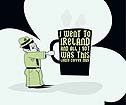Many years ago, my mom took a pilgrimage to Europe with two of her college friends. In Ireland, they walked half the day, searching for the house where my great-great-grandmother grew up. They found it, as well as its very skeptical current owners. They let my mom look through the house and offered her a shot glass of whiskey. All my mom and her friends really wanted was a glass of water, but apparently Irish hospitality calls for whiskey shots.
Once she had kids, my mom realized that hard liquor was one aspect of Ireland she wasn't going to share. She did, however, share the food. Every St. Patrick's Day, she cooked up a big pot of corned beef, cabbage and potatoes. We also had to wear green on the Irish holiday or risk being pinched. The worst thing was when my mom snuck into my room while I was still sleeping, woke me up and pinched me because I didn't have any green on. I was fighting Irish mad. I think I could have benefited from a shot of whiskey at that point.
After I grew up, getting pinched on St. Patrick's Day was the least of my worries. My first St. Paddy's parade in Jackson was cold and rainy. I stood without an umbrella under the drizzle and grabbed beads out of the sludge in the gutters. Next to us, tipsy ladies in big pink hats drank vodka to keep the tipsiness going. All I wanted to drink was something hot.
The desire for warmth was what prompted the invention of Irish coffee. In the late 1930s, Americans traveling to Ireland had to endure a damp, cold, 18-hour seaplane flight. When they arrived in Foynes, in County Limerick, passengers very much appreciated a cup of hot coffee or tea.
Head chef Joseph Sheridan, who worked for the Foynes catering service, thought that passengers might like something with a bit more kick to it. After a lot of trial and error and late-night tasting sessions, Chef Sheridan came up with the perfect concoction: Irish coffee.
In 1947, when the Shannon International Airport opened across the river from Foynes, Irish coffee became the official welcoming drink.
Here in the U.S., on Nov. 10, 1952, at the Buena Vista Cafe in San Francisco, then-owner Jack Koeppler and international travel writer Stanton Delaplane set out to discover the secret of Ireland's coffee-with-a-kick. After much research, taste testing, and a field trip to the Shannon Airport, the recipe was perfected. Irish coffee is now served throughout the world and has been enjoyed by everyone from Fidel Castro to movie actress Maureen O'Hara and George Bush Sr.
I contacted Claire McEnery, a media representative from the Shannon Airport, who confirmed that Irish coffee is still served there today. She also shared Joe Sheridan's personal recipe with me.
There are only four ingredients in an Irish coffee: coffee, Irish whiskey, sugar and whipping cream. It's the correct assembly of the ingredients that make or break the drink.
For those of you who are skeptical about the double-bad whammy of caffeine and alcohol, consider this: A study was released last year that proved that coffee actually diminishes the effects of alcohol on the liver. Hey, we Irish could have told you that years ago. So, lift your glasses high, throw back that red hair (or whatever color), and as the Irish say, Slainte!
Heat a clear glass mug by filling it with hot water. Pour in one shot (one ounce) of Irish whiskey. (This is an approximation. I'm a wimp when it comes to hard liquor, so I used about a tablespoon.) Add 1-2 tablespoons of brown sugar and strong black coffee up to an inch below the rim of the glass. Stir gently. Top with a good inch of whipping cream. (The whipping cream is the most important part, in my opinion. Get the heavy whipping cream and whip it when it's cold.)
The coffee is meant to be drunk through the layer of whip cream. It's actually a delightful experience; the creaminess softens the taste of the whiskey and sweetens the coffee.



Comments
Use the comment form below to begin a discussion about this content.
comments powered by Disqus